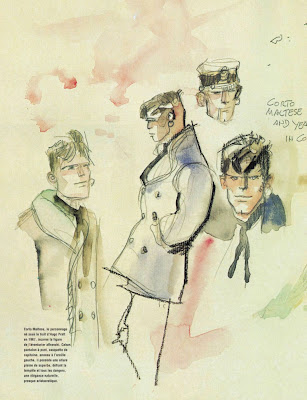
The Dutch comic, EPPO, has had more than one incarnation, and over the years it has published many great strips by great cartoonists, including Aloys Oosterwijk, Gerard(Gleever)Leever and Peter de Wit. The latest incarnation of EPPO Stripblad, launched in January of this year, is seen by some though, as a retrograde step, an attempt at reviving a form of comic that is no longer fashionable, overtaken in popularity, as it has been, by the graphic novel and the bande dessinée. It is a familiar story, and it is one that I hope has a happy ending because, like most every cartoonist out there, I want there to be as many markets as possible for our work.
I'm sure that the UK cartoonists out there will see the similarities between India's Comic Digest(see blog below) and EPPO Stripblad, and old IPC and DC Thomson titles. The major difference between the Indian publications and EPPO and the old British titles is that the Indian titles rely more heavily on syndicated US strips, rather than European work. In many ways India's Comic Digest is more like a US Sunday Funny insert, with one or two old IPC pages thrown in. Whereas EPPO Stripblad, with its Belgian influences, is more like IPC's Giggle Comic (see earlier blog here) than its Indian counterpart.

The lead comic in EPPO, Storm and Red Hair, is an example of the science fantasy comic series that has proved so popular in Europe over the post-war decades. It was originally drawn by the great Don Lawrence.

Eric Heuvel's January Jones, is a comic set in the 1930s, about a female pilot. The series was written by Martin Lodewijk and was published in the magazine Sjosji until the late 1990s.

The main force behind De Partners is illustrator and scriptwriter Dick Matena, who in addition to writing scenario's for the Carry Brugamn illustrated De Partners, also wrote for the Don Lawrence illustrated Storm (he also illustrated the Storm mini-series Kronieken van de Tussentijd).

Franka, the story of a Dutch, female, detective, is a very popular Dutch comic book series, and strip cartoon, by Henk Kuijpers.

Uco Egmond is one of the two EPPO cartoonists who can be likened to Britain's Leo Baxendale, in comic creator terms. From his debut with the gag strip Eppo in the magazine Pep, his work has been a constant. When the magazines Pep and Sjors merged in the 1970s, they became Eppo Magazine, named after Egmond's character. He co-created De Leukebroeders along with Peter Coolen and together they work under the pseudonym, Peco.

Dick Heins is another prolific cartoonist who in addition to working on Kleine Napoleon with Frank Jonker, inks and colours Uco Egmond's Eppo strip.

The team behind the Belgian comic series Plunk, a series of wordless stories about a little pink alien with green trousers and a green hat, from the planet Smurk, are Luc Cromheecke and Laurent Letzer. Plunk, created somewhat ironically as an experiment on behalf of the Belgian Centre for Comic Strip Art as an example of cartoon merchandising, became a very popular strip in its own right, was collected in several albums, and was republished in Spirou Magazine.

Kim Duchateau is just one of a group of talented new young Belgian comic artists. His comic, Esther Verkest, is also published in other magazines besides EPPO.

Bob Evers is the work of writer Frank Jonker, and illustrator Hans van Oudenaarden. There are some marvelous pics and a lot of info' about creating the new BOB EVERS comic books, on the pair's blog here, in English.

Flippie Flink is of course Beetle Bailey. It's a popular strip all over the world. They must be doing something right.

Havank, by Daan Jippes, is a series of exciting detective stories.

Jean-Marc van Tol, of Fokke & Sukke fame, is also the artist of the comic series Kort en Triest, on which he works with Herman Roozen.

De Stamgasten is by the other EPPO cartoonist who can be likened to Leo Baxendale, Toon (Antonie Marcel) Van Driel. His many great creations for Eppo, Eppo/Wordt Vervolgd and Sjors en Sjimmie Stripblad, the daily press, and television, all combined to see him awarded the Stripschapprijs, the most important Dutch comic award.
And finally Eppo, by Uco Egmond, coloured by Kliene Napoleon's Dick Heins.
Over all, I think the balance of Eppo Stripblad is really nice, it amounts to a pleasing, enjoyable and funny read. It's also great to look at, and not stuffed to the gills with syndicated US strips. I'd love to see this sort of publication over here in the UK, supporting some new UK strips, which might in turn help foster an appetite amongst UK comic fans for volumes of work featuring their favourite characters. I've also long been an advocate of this sort of publication appearing as an insert in US papers, funding the publisher with national adverts, and the newspapers with local adverts. Perhaps, as the amount of print publications continues to diminish, and those that are left drop their comic strips, it will be a business model that someone might want to take a long, hard, look at, again.



































